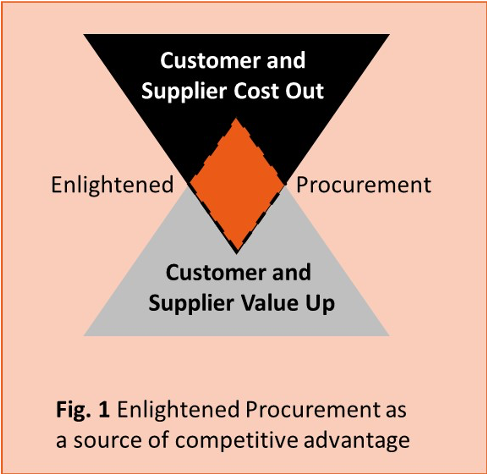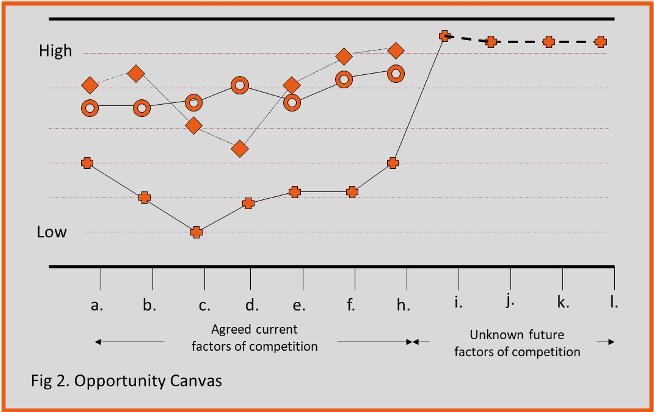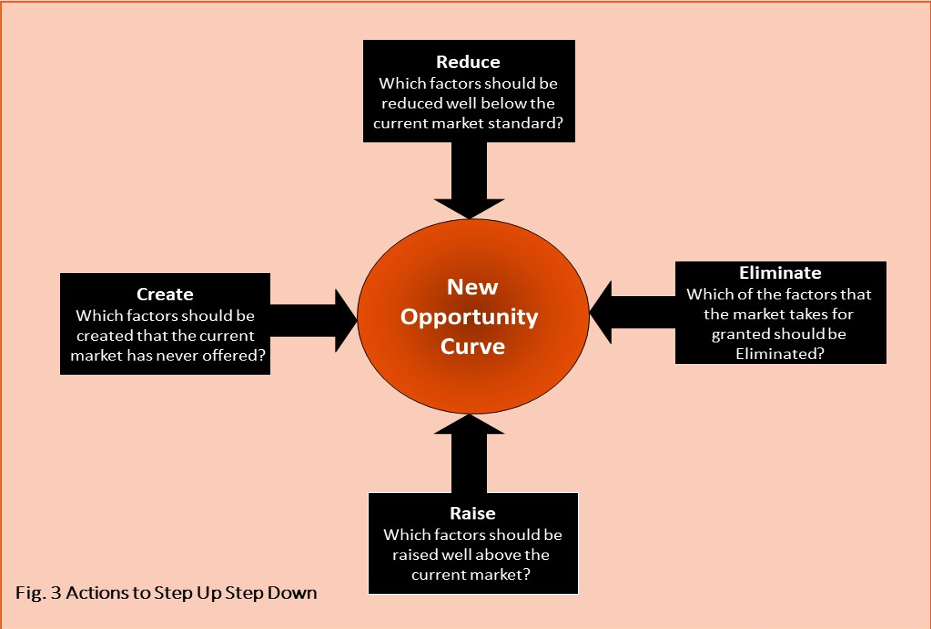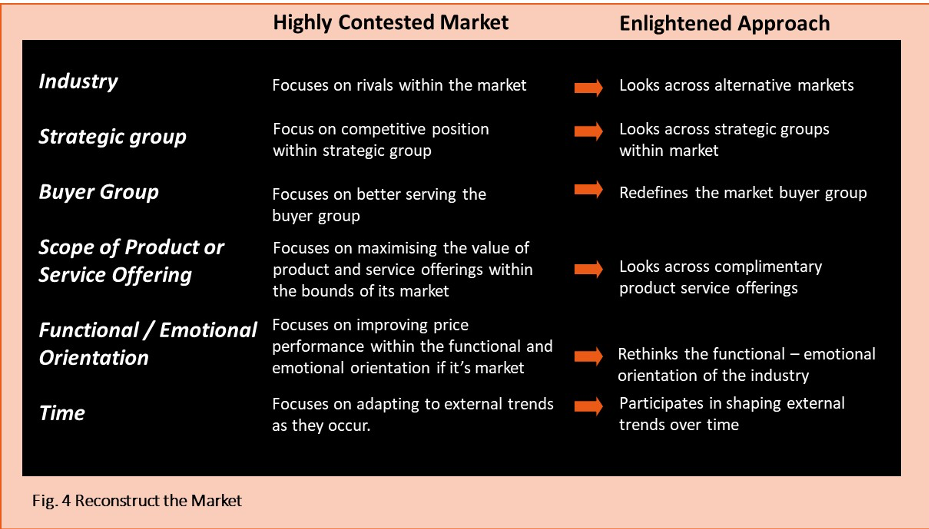Focus on Costs: Day 10 – Business Wide Enlightened Approach – External
Today is the final article in this series aimed at helping organisations to Focus on the Bottom Line using a concept developed within JMCL which we refer to as Enlightened Procurement.
This concept is all about the simultaneous realisation of dramatic cost reduction and increased value to an organisation from its 3rd party suppliers. During these articles we have applied the concept to functional procurement and finance operations. The concept however is widely applicable across an organisation.
Our Enlighted Procurement philosophy is reflected in the concept of Value Innovation conceived at INSEAD and published as Blue Ocean Strategy in 2004 by Rene Mauborgne and W. Chan Kim. It presents the concept of value innovation through a range of models which help the reader to look at the world of innovation and is the subject of today’s, final instalment. The concept is that the environment in which an organisation competes, is like a sea awash with blood; that is Red Oceans in which sharks and other predators are swimming. The authors encourage businesses to innovate and develop new ways in which to compete; that is to create Blue Oceans. In Blue Oceans there is no blood in the water; at least in the first instance. Just clear blue water where competition is obliterated.
The key criterion of a Blue Ocean is the simultaneous realisation of ‘off the scale’ cost reduction for customers and suppliers and ‘off the scale’ rises in customer and supplier value. The sweet spot which arises when these characteristics emerge is the holy grail of businesses. In our world we call it Enlightened Procurement.
We at JMCL are motivated by increased efficiencies, in other words doing more with less. We back ourselves to take risks and generate customer benefits from which we are rewarded. Ours is not a world of slash and burn though; ours is a world where we strive to innovate customer value as a source of competitive advantage. Yes, we look closely at all costs, including the quick wins and low-hanging fruit. However, we also challenge ourselves to find better ways of doing business. We find that by keeping the ambition of Blue Oceans in mind we can work with customers and suppliers to win-win outcomes.
Enlightened Procurement as a source of competitive advantage…
We show Enlightened Procurement in Figure 1 as the confluence of unrivalled cost out for both customers and suppliers and unrivalled value up for both customers and suppliers.

A recent example of JMCL delivering value innovation, as Chan and Maubourge define it, was in a multinational healthcare organisation which had been buying packaging for years and had worked on specification and just in time deliveries from suppliers to their factories.
The organisation had grown through acquisition and there was territorial commitment to certain legacy suppliers meaning that 22 factories were being served by 18 suppliers. All suppliers provided a similar quality and service into their customer factories however the different factories didn’t see it this way. This was a barrier to the realisation of value innovation. Another was that only a few suppliers were multi-national across the territories in question and finally the portfolio of end customers was increasingly requiring smaller order quantities.
JMCL worked closely with the client organisation to breakdown the inbound goods into key critical elements. A progressive negotiation, using principled negotiation techniques, was utilised to funnel the supply base into a few likely candidates who could think differently.
A new specification of supply was created against which the final few suppliers made a bid linked to an extended contract duration. The outcome was that a single supplier was awarded the business with appropriate risk management arrangements in place.
The suppliers utilised its critical printing assets centrally to good effect and then delivered printed card on pallets into the customer factories where finishing equipment was installed in the on-site warehouse. Batch printing, folding and gluing was one on site in the required batch quantities.
The value innovation delivered the following competitive advantages:
- Lead times from two weeks to hours meaning that machine efficiency increased by 26%
- End-customer service increased dramatically taking nearly a week off typical delivery times which had a positive finished product inventory impact.
- The interfaces with the supplier dropped impacting local head count therefore reducing local overhead at the JMCL client
- The price paid per item fell by over 20% as a result of the volume increases
- The successful supplier, once full implementation was reached, would see a 6% increase in margin realised on this business.
The process to realise this new way of doing business was conceived and delivered with JMCL know how and subject matter expertise. This brave new world will see the JMCL customer profitably swimming in Blue Oceans while the market struggles to catch up.
Business Wide Enlighted Approach – External
At the heart of Value Innovation is a direction of travel towards new uncontested markets for organisations, not just their procurement orientated towards third party costs and added value. It is about redefining the market in which an organisation operates and in doing so creating uncontested ‘blue-waters’. The case study to demonstrate this concept is that of Southwest Airlines in the United States.
A very useful tool as a touchstone for the case study and one which can be easily adapted for use in strategic THINKING exercises is shown in Fig. 2 Opportunity Canvas.

This is a tool which presents the basis of competition, in a market, listed along the horizontal axis and the extent to which each competitor in the market is relying upon their application of these different features to position themselves in the market. This also enables an industry curve to be developed by aggregation. The relative positions can be plotted using corporate intelligence – formal market research and inside knowledge. Perception plays a significant role in this exercise.
If this tool is applied to the internal airlines market in North America, the features listed along the horizontal axis may have included the following:
- Arrival and departure location near major cities
- Duration of Flights
- Check In
- Catering / Service
- Seats
- Status
- Lounges
- Staff presentation
- Competing with certain other airlines
- Reliability
- Flight time of day – typically few or a few more flights but at prime times
- Price
- Relaxed approach for customers
All airlines were competing for custom in ‘red-oceans’, filled with blood. Attack and counterattack by playing slightly different tunes on the recognised basis of competition. Southwest plotted their curve relative to competitors and the industry. They then asked ‘what if we don’t play this game? What if we play a different game? What if we redefine the basis of competition for example what if we compete with the car rather than other airlines? This shift in thinking was seismic and gave birth to the low-cost airlines industry. This simple challenge then opened all of these features to recalibration and the creation of new features which would define the new market, such as, but not limited to, a move towards ‘self-service’ for check in for example.
Southwest went on to reduce or eliminate many of the attributes of their proposition such as:
- Move away from main city airports with connectivity to other local airfields closer into cities
- Move away from segmented seating towards a single standard class
- Move away from in flight catering to no catering or a chargeable option
- Move away from very popular time of day flights to less popular times
- Elimination of lounges
- Elimination of the concept of status
- Move away from similar pricing based upon features to extremely low pricing
Southwest then looked at new attributes upon which they can compete. We already mentioned the idea of competing against the car thereby the concept of ‘convenient point to point’ was conceived but there were others such as self-service check-in and strict adherence to boarding with fast turn around for planes on the ground thereby they also dramatically increased the number of flights available. They also maximised the friendliness of the staff towards customers. This bold strategy defined a new market for Southwest to operate in. This bold move made Southwest a standout disruptive force in offering huge cost reduction compared with their previous competitors and significantly offering more customer value by taking them closer to their destinations, as if the customer was driving, and all with a big southern smile.
This type of THINKING is not the exclusive domain of historic case studies and academic texts; it can be applied to any business, business unit or functional level. The first step is to use the TIME you currently have available to ask the simple question ‘What if……?’ Should you take the TIME you are now afforded to ask this question and allocate it to THINKING and pondering the answers without limitation, then the chances are that you will be in a far better position for picking up the pieces once the current crisis diminishes. Should you choose to take this path then JMCL has a few more tools which might assist you on the journey.
Enlightened Innovation Principles
Formulation Principles
- Reconstruct market boundaries
- Focus on the big picture, not the numbers
- Reach beyond existing demand
- Get the strategic sequence right
Execution Principles
- Overcome key organisational hurdles
- Build execution strategy
Building a New Opportunity Curve and Redefining the Boundaries of the Market
The key questions for the creation of an opportunity canvas are set out in Fig. 3 below and the THINKING framework to support the Enlighted Approach in the table Fig. 4 Reconstruct the Market.

……

Statement from JMCL
We do hope that this series of articles present daily over that last two weeks have been useful. They were created to help organisations use this period of crisis to use the TIME they have been afforded to THINKabout what they can do to focus on the bottom line and simultaneously add value to their organization and its customers. We have not limited ourselves solely to the Procurement area but have extended our Enlightened Approach at a business level.
We will be posting various insights into our Enlightened Approach over the following weeks as we work our way through this crisis and come out of the other side however this series of articles is now complete.
If you have any questions about any of the articles or have case studies using these ideas or merely want to discuss how these concepts can be applied to your please do not hesitate to contact me:
Jonny Michael
CEO JMCL Consulting Limitedj.michael@jmclconsulting.com



